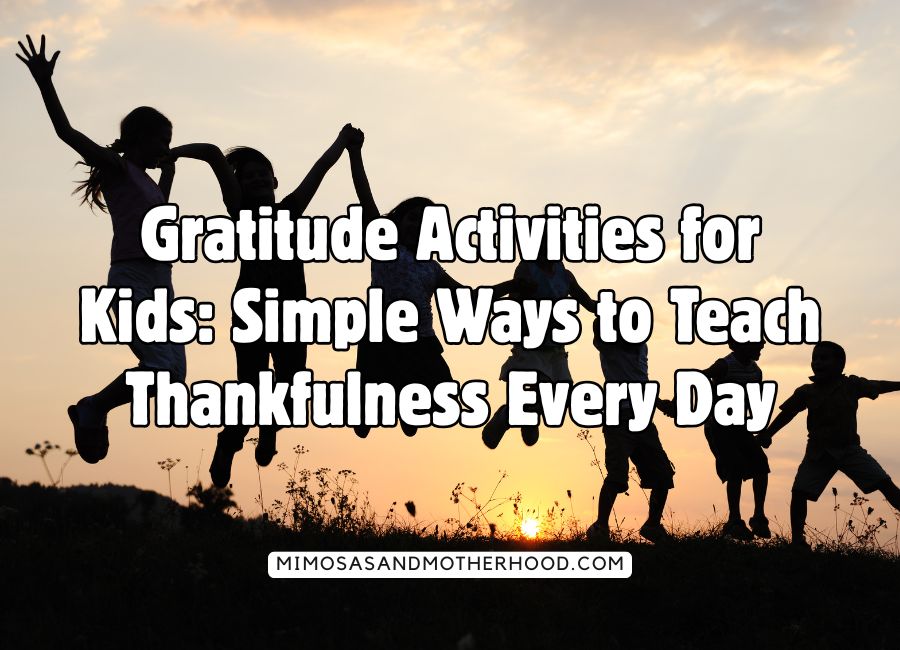15 Gratitude Activities for Kids: Simple Ways to Teach Thankfulness Every Day
Looking for easy ways to teach kids gratitude? These fun and meaningful activities help kids learn thankfulness through crafts, journaling and family rituals they’ll love.

If you’ve ever asked your child to say “thank you” and been met with a blank stare or mumbled word, you’re not alone. Gratitude doesn’t always come naturally, especially for little kids who are still learning how to name their feelings and needs.
The good news? Gratitude can be taught! The best part is, it’s actually fun to practice as a family.
Teaching thankfulness through simple, everyday activities helps children develop empathy, kindness, and resilience. These easy gratitude activities for kids will help your family slow down, connect, and notice the good that’s all around you.
Note: Some links may be affiliate links. That means I may make a commission if you use my links to purchase, at no extra added cost to you! I only recommend products that I personally love and believe in. Full disclaimer here.

Why Gratitude Matters for Kids
Gratitude isn’t just about manners—it’s about mindset. Studies show that kids who regularly practice gratitude:
- Have better emotional regulation and fewer meltdowns
- Feel more connected to others and more confident
- Experience less anxiety and better sleep
- Are more likely to show kindness and empathy
And as parents, when we model gratitude ourselves, it helps shape how our kids see the world. The more they see us acknowledging small blessings, like a warm meal, a kind friend, a sunny day, the more they learn to look for the good, too.
- Start a Family Gratitude Jar
This simple family tradition is one of the easiest ways to make thankfulness a daily habit.
All you need is a jar, slips of paper, and a few minutes each day. Ask your kids what made them smile, write it down, and drop it in the jar. Over time, it becomes a collection of joyful memories you can revisit anytime your family needs a little boost.
- Gratitude Drawing Time
Even toddlers can express gratitude through art. Provide crayons, markers, and paper, and ask, “Can you draw something that made you happy today?”
You might be surprised by their answers. Ice cream, grandma’s hug, or their favorite stuffed animal all count!
Hang the drawings on the fridge or create a “gratitude wall” that grows each week.
- Create a Thankful Tree
Cut a tree trunk shape out of brown paper and tape it to a wall or window. Have your kids cut out (or color) paper leaves, then write or draw one thing they’re thankful for on each leaf.
Add new leaves throughout the month (especially in November) to create a beautiful visual reminder of your family’s blessings.

- Read Books About Gratitude
Storytime is one of the most natural ways to teach life lessons.
A few of our family favorites include:
Bear Says Thanks by Karma Wilson
The Thank You Book by Mo Willems
Gratitude Is My Superpower by Alicia Ortego
Each story helps kids understand gratitude in a way that feels relatable, not preachy.
👉 Check out: Best Thanksgiving Books for Kids for even more ideas.
- Practice “Thankful Thursdays”
Choose one day a week to focus on gratitude. During dinner or bedtime, ask everyone to share three things they’re thankful for that day. Keep it lighthearted—silly answers are welcome!
This small, consistent ritual builds long-term habits without feeling forced.
- Make a Kindness Countdown Chain
Cut strips of paper and write simple acts of kindness on each one—like “tell someone you love them,” “pick up toys without being asked,” or “make a card for Grandma.”
Each day, your child pulls one link off the chain and completes the activity. By the end of the month, they’ll see how small actions can create big waves of kindness.
- Keep a Gratitude Journal
For older preschoolers and early elementary kids, keeping a gratitude journal is a great way to build writing skills and mindfulness at the same time.
Let your child decorate their own notebook and start with simple prompts like:
- “Today I’m thankful for…”
- “Something that made me laugh…”
- “Someone who helped me…”
Encourage pictures for younger children who aren’t writing yet. We incorporate this every year into our New Years Eve family plans by working through this year-end reflection workbook for families.
- Say Thank You Out Loud
It sounds simple, but modeling gratitude verbally is one of the most powerful ways to teach it.
Try this: when your partner empties the dishwasher or your child shares their snack, pause and say, “Thank you—that really helps.”
The more your kids hear gratitude expressed naturally, the more it becomes part of their own daily language.
- Go on a Gratitude Nature Walk
Head outside and take a slow walk as a family. Ask your kids to look for things they appreciate in nature, like the crunch of leaves, a colorful flower or a warm breeze.
For an extra activity, collect small treasures like acorns or stones and turn them into a “thankful nature collage” when you get home.

- Write Thank You Notes Together
After birthdays, holidays, or anytime someone gives your family a gift, take time to write thank-you notes together.
Little kids can draw pictures while you write their words for them. Older kids can help with simple sentences like, “Thank you for my book. It makes me happy every time I read it!”
- Make a “Thankful Collage”
Cut photos from old magazines or print family pictures and glue them to a poster board. Add words and doodles around the edges showing what your child is thankful for.
It’s an easy, tactile activity that sparks conversations about the people and things they love most.
- Practice “Gratitude ABCs”
At bedtime, challenge your kids to name one thing they’re thankful for that starts with each letter of the alphabet.
For example:
A – apples
B – brothers
C – cookies
It’s a fun way to build vocabulary and end the day on a positive note.
- Create a Family Gratitude Ritual
Whether it’s lighting a candle, saying a short gratitude prayer, or sharing one highlight of the day before dinner, having a consistent gratitude ritual helps kids feel grounded and calm.
Consistency is key. Gratitude grows from small, repeated moments.
- Do a Family Service Project
Helping others is one of the best ways to inspire thankfulness. You don’t have to wait for the holidays to give back! Try:
- Donating old toys or clothes together
- Baking cookies for a neighbor
- Making cards for nursing home residents
When kids see the joy their kindness brings to others, it deepens their sense of gratitude. Our family does the Santa Sack tradition and a Reverse Advent Calendar each Christmas. My kids look forward to it now every year!
- Read Old Gratitudes Together
If you’ve started a Family Gratitude Jar, make it a tradition to read a few notes every month, or whenever someone needs a pick-me-up.
Kids love remembering the funny, sweet, or silly moments they’ve written down. It’s like finding hidden treasure in your own home.
Teaching Gratitude Year-Round
Gratitude isn’t just for Thanksgiving. It’s a mindset that can shape your child’s outlook all year long.
By weaving small moments of thankfulness into your routines, you’ll help your children build empathy, joy, and resilience that lasts a lifetime.
And maybe, just maybe, you’ll find yourself feeling a little more grateful, too.
Did you enjoy this article? Use the image below to pin it on Pinterest to help other families find this useful information, too!







